Is It Safe To Drive Or Fly? When pondering travel, safety is paramount. On flyermedia.net, we delve into a detailed comparison of driving versus flying safety, focusing on general aviation (GA) to help you make informed decisions about air travel and assess the risks associated with different modes of transportation. We aim to provide you with the knowledge and resources to navigate the skies safely, offering insights into flight training, aviation news, and career opportunities.
1. Understanding the Core Question: Is Flying as Safe as Driving?
The immediate answer is: Generally, no, general aviation flying is not as safe as driving, especially when considering personal flights. While commercial airlines boast impressive safety records, GA, encompassing private planes and personal flights, presents a different risk profile. This article will explore accident data, common causes of GA accidents, and strategies for enhancing aviation safety.
Flying in a commercial airliner is statistically safer than driving, but general aviation (GA) flights, particularly personal flights, carry a higher risk than driving. This is due to various factors, including pilot error, mechanical issues, and weather conditions, which contribute to the accident rates in GA.
1.1. Comparing Accident Rates: A Statistical Dive
Directly comparing driving and flying accident rates can be tricky due to different measurement methods. The National Highway Traffic Safety Administration (NHTSA) measures accidents per 100 million vehicle miles traveled, while the National Transportation Safety Board (NTSB) uses accidents per 100,000 flight hours.
Here’s a breakdown:
| Metric | Driving (NHTSA) | General Aviation (NTSB) |
|---|---|---|
| Measurement | Accidents per 100 million vehicle miles | Accidents per 100,000 flight hours |
| Example Data (2021) | 1.37 fatalities per 100 million miles | 0.95 fatalities per 100,000 flight hours |
To get a clearer picture, we need a common metric, such as fatal accidents per million hours. A 2020 study provides this, showing 0.6 to 0.7 fatal car crashes per million hours driven. In contrast, overall GA had 9.5 fatal crashes per million flight hours in 2021, about 14 times the driving fatality rate.
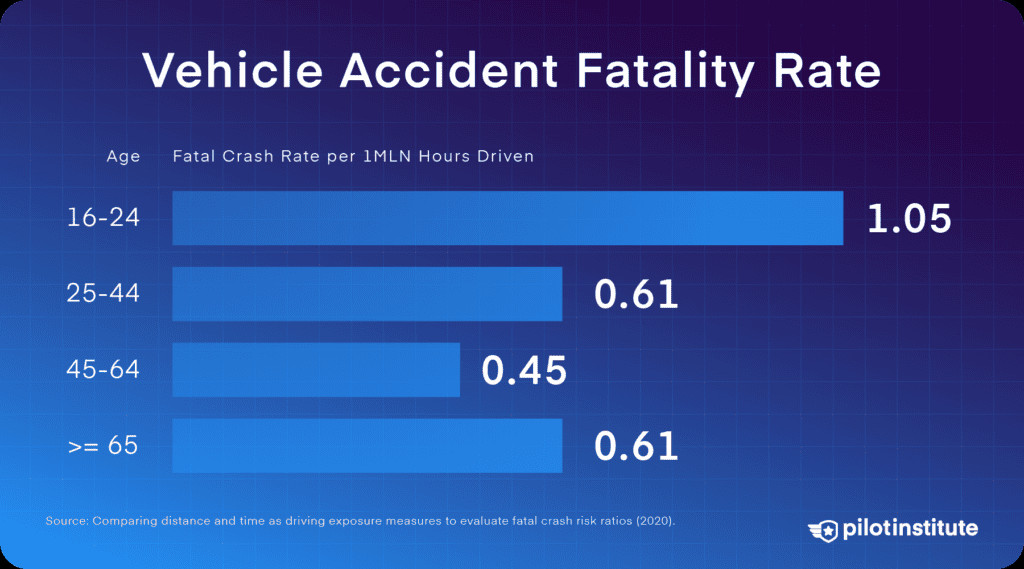 Vehicle accident fatality rate by age
Vehicle accident fatality rate by age
1.2. The Nuances of General Aviation: Personal vs. Instructional Flights
Not all GA flights are created equal. Corporate aviation, for instance, is relatively safe, with 0.48 fatal accidents per million flight hours (2012-2021). However, personal flights, comprising 67% of GA accidents and 72% of fatalities, paint a different picture. These “hundred-dollar hamburger runs” and family trips saw 21.1 fatal accidents per million flight hours during the same period, over 27 times the driving fatality rate.
Instructional flights, on the other hand, are significantly safer, with 2.3 fatal accidents per million flight hours—only 3.4 times more dangerous than driving.
| Flight Type | Fatal Accidents per Million Flight Hours (2012-2021) |
|---|---|
| Corporate Aviation | 0.48 |
| Personal Flights | 21.1 |
| Instructional Flights | 2.3 |
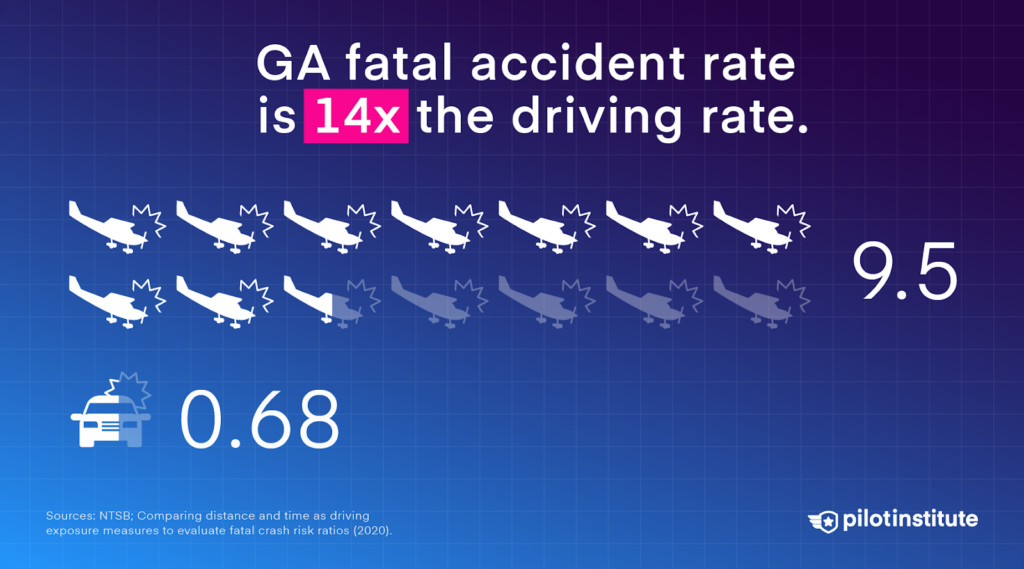 The GA fatal accident rate is roughly 14 times that of driving
The GA fatal accident rate is roughly 14 times that of driving
2. What are the Key Risk Factors in General Aviation?
The AOPA’s Richard G. McSpadden Report categorizes accidents into Pilot-related, Mechanical, and Other/Unknown causes. Pilot-related issues are the most significant factor.
2.1. Pilot Error: The Leading Cause
Pilot error accounts for 69% of all GA accidents, making it the most critical risk factor. This includes loss of control in-flight (LOC-I), improper decision-making, and inadequate flight planning.
2.2. Mechanical Failures: A Significant Concern
Mechanical failures contribute to about 16% of all accidents, although they result in fewer fatalities compared to pilot-related issues. Engine failures are the most common type of mechanical problem, but surprisingly, most are manageable emergencies. Fuel-related issues, such as contamination, starvation, and exhaustion, also fall under this category.
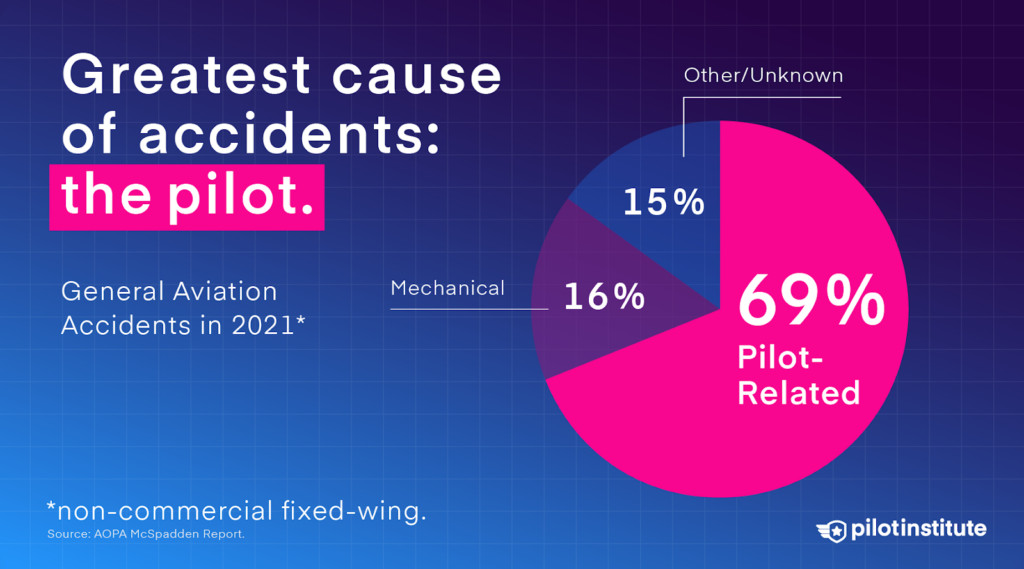 The greatest cause of GA accidents is the pilot
The greatest cause of GA accidents is the pilot
2.3. Other/Unknown Causes: The Unexplained
About 15% of all accidents and 28% of fatal ones have no clear cause, making it difficult to learn from them and implement preventative measures.
3. Diving Deeper: What Specific Pilot Errors Cause the Most Accidents?
The NTSB classifies pilot-related causes as “defining events,” providing a more detailed view of accident factors.
3.1. Loss of Control In-Flight (LOC-I)
Loss of control in-flight is the most common and fatal cause of GA accidents. It often involves stalls and spins in the traffic pattern during maneuvering flight, which are rarely recoverable.
3.2. Landing Accidents
While many GA accidents occur during landing, they are typically less fatal. Loss of control is the most common type of landing accident.
3.3. Takeoff and Climb Accidents
Takeoff and climb accidents have a higher fatality rate because the aircraft is in a low-energy, low-altitude state with little room for error. Stalls are the deadliest cause of takeoff and climb accidents.
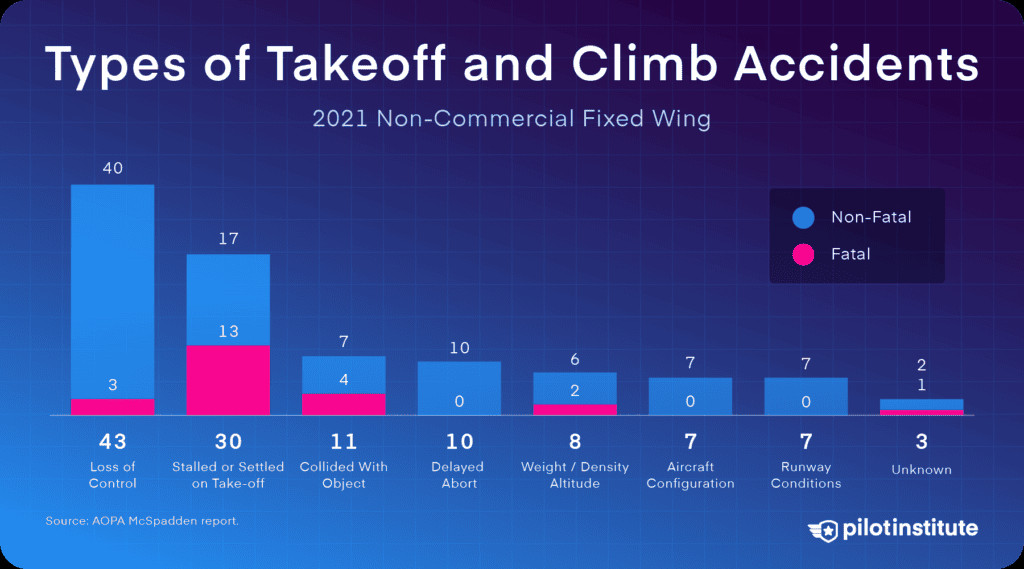 Types of GA takeoff and climb accidents
Types of GA takeoff and climb accidents
3.4. Controlled Flight into Terrain (CFIT)
Controlled Flight Into Terrain (CFIT) is an unintended collision with the ground or an obstacle, often resulting from a loss of situational awareness.
3.5. Unintended VFR Flight into IMC
Flying visually into clouds or low visibility (instrument meteorological conditions) had a 71% fatality rate in 2021, highlighting the dangers of unintended VFR flight into IMC.
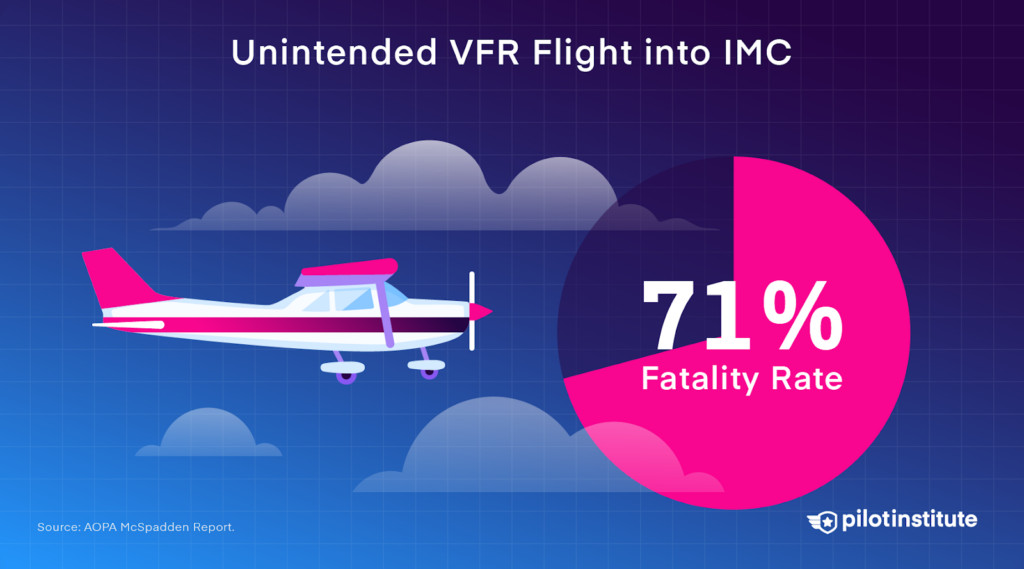 Unintended VFR flight into IMC has a 71% fatality rate
Unintended VFR flight into IMC has a 71% fatality rate
4. How Can We Mitigate Risks in General Aviation?
While GA flying may never be as safe as driving, several measures can reduce risk and enhance safety.
4.1. Proficiency Over Currency
Staying proficient requires more than just meeting the legal minimums. Continuous training and skill enhancement are essential.
4.2. Learning from Instructional Flights
Instructional flights have a lower fatality rate due to a supervised environment, structured operations, and higher pilot proficiency.
4.3. Modeling a Safety Mindset
Adopting a risk-averse approach and adhering to strict safety protocols can significantly reduce accidents.
5. Safety Measures and Best Practices: What Actions Can Pilots Take?
To enhance safety in general aviation, pilots can adopt several best practices:
5.1. Regular Training and Proficiency Checks
Pilots should engage in continuous training and proficiency checks to maintain and improve their skills. This includes recurrent training in emergency procedures, instrument flying, and handling unusual attitudes.
5.2. Thorough Pre-Flight Inspections
Performing thorough pre-flight inspections can help identify potential mechanical issues before they lead to accidents. This includes checking fuel levels, control surfaces, engine components, and all critical systems.
5.3. Detailed Flight Planning
Detailed flight planning is crucial for avoiding weather-related accidents and fuel exhaustion. Pilots should carefully assess weather conditions, plan routes, and calculate fuel requirements with a safety margin.
5.4. Risk Management
Effective risk management involves identifying potential hazards and implementing strategies to mitigate them. This includes assessing pilot fatigue, aircraft condition, weather conditions, and any other factors that could compromise safety.
5.5. Adherence to Regulations and Procedures
Strict adherence to regulations and standard operating procedures is essential for maintaining safety in aviation. Pilots should stay current with all applicable regulations and follow established procedures for all phases of flight.
6. What Factors Contribute to the Safety of Instructional Flights?
Instructional flights are notably safer than personal flights due to several key factors:
6.1. Supervised Environment
Instructional flights take place in a supervised environment with a qualified flight instructor present. The instructor provides guidance, monitors the student’s performance, and intervenes when necessary to prevent errors.
6.2. Structured Operations
Flight schools operate with highly structured procedures and protocols designed to minimize risk. These include standardized training syllabi, checklists, and emergency procedures.
6.3. High Maintenance Standards
Flight schools typically maintain their instructional aircraft to high standards, with frequent inspections and maintenance to ensure airworthiness.
6.4. Proficient Instructors
Flight instructors tend to be more proficient than private pilots who fly less frequently. They undergo rigorous training and evaluation to maintain their certification and provide quality instruction.
7. How Do Weather Conditions Impact Aviation Safety?
Weather conditions play a significant role in aviation safety, particularly in general aviation. Adverse weather can lead to loss of control, CFIT, and other types of accidents.
7.1. Icing
Icing can significantly impair aircraft performance, reducing lift and increasing drag. Pilots must be trained to recognize and avoid icing conditions or to use de-icing equipment when necessary.
7.2. Low Visibility
Low visibility conditions, such as fog, haze, or heavy rain, can make it difficult for pilots to maintain situational awareness and avoid obstacles. Pilots must be proficient in instrument flying techniques to safely navigate in low visibility.
7.3. Turbulence
Turbulence can cause loss of control and structural damage to aircraft. Pilots should avoid flying in areas of known turbulence or be prepared to manage turbulence safely.
8. What is the Role of Technology in Improving Aviation Safety?
Technology has played a significant role in improving aviation safety over the years. Advanced avionics, navigation systems, and safety features have helped to reduce the risk of accidents.
8.1. Enhanced Ground Proximity Warning Systems (EGPWS)
EGPWS provides pilots with alerts when they are in danger of flying into terrain, helping to prevent CFIT accidents.
8.2. Traffic Collision Avoidance System (TCAS)
TCAS helps pilots avoid mid-air collisions by providing alerts and guidance on evasive maneuvers.
8.3. Automatic Dependent Surveillance-Broadcast (ADS-B)
ADS-B provides air traffic controllers and pilots with real-time information about aircraft position and altitude, improving situational awareness and reducing the risk of collisions.
9. How Can Pilots Improve Their Decision-Making Skills?
Good decision-making is crucial for aviation safety. Pilots can improve their decision-making skills through training, experience, and the use of decision-making tools.
9.1. Risk Assessment Tools
Risk assessment tools, such as the FAA Risk Management Handbook, can help pilots identify potential hazards and assess the level of risk associated with a particular flight.
9.2. Scenario-Based Training
Scenario-based training involves simulating realistic flight scenarios to help pilots develop their decision-making skills in a safe environment.
9.3. Mentorship Programs
Mentorship programs can provide pilots with guidance and support from experienced aviators, helping them to make better decisions and avoid common pitfalls.
10. How Can Flyermedia.net Help Aspiring and Current Pilots?
Flyermedia.net provides a wealth of information and resources for aspiring and current pilots, including:
- Comprehensive Flight Training Information: Find detailed information about flight schools, training programs, and certification requirements. Whether you’re looking to start your flight training or advance your skills, we have the resources to help you succeed.
- Up-to-Date Aviation News: Stay informed about the latest developments in aviation, including safety alerts, regulatory changes, and technological advancements.
- Career Opportunities: Explore job opportunities in the aviation industry, from pilot positions to maintenance technician roles.
- Expert Insights: Access articles and guides written by aviation professionals, covering a wide range of topics related to safety, training, and career development.
Conclusion: Making Informed Decisions
While general aviation flying presents inherent risks, understanding these risks and adopting proactive safety measures can significantly enhance safety. By prioritizing proficiency, adhering to best practices, and leveraging available resources, pilots can enjoy the freedom of flight while minimizing the potential for accidents. At flyermedia.net, we are committed to providing you with the information and tools you need to make informed decisions and navigate the skies safely.
Data sources such as the NTSB and AOPA, along with research from institutions like Embry-Riddle Aeronautical University, provide valuable insights that can inform pilot training and safety protocols. Remember, a well-informed pilot is a safer pilot.
Ready to take your aviation journey to new heights? Visit flyermedia.net today to explore flight training options, stay updated with the latest aviation news, and discover exciting career opportunities in the USA. Your dream of flying starts here! Our address is 600 S Clyde Morris Blvd, Daytona Beach, FL 32114, United States, and you can reach us at +1 (386) 226-6000.
FAQ: Addressing Your Concerns About Aviation Safety
1. Is commercial airline travel safer than driving?
Yes, commercial airline travel is statistically safer than driving. Airlines have stringent safety regulations, highly trained pilots, and robust maintenance programs.
2. What makes personal GA flights riskier than driving?
Personal GA flights are riskier due to factors like pilot error, mechanical issues, and less structured operational environments compared to commercial airlines.
3. How can I reduce the risk of accidents in general aviation?
You can reduce the risk by prioritizing proficiency over currency, undergoing regular training, conducting thorough pre-flight inspections, and adhering to strict safety protocols.
4. What is the most common cause of accidents in general aviation?
Pilot error is the most common cause, accounting for 69% of all GA accidents.
5. Are mechanical failures a significant concern in GA?
Yes, mechanical failures contribute to about 16% of accidents, with engine failures being the most common type.
6. What is Loss of Control In-Flight (LOC-I)?
LOC-I is the most common and fatal cause of GA accidents, often involving stalls and spins during maneuvering flight.
7. How do weather conditions affect aviation safety?
Adverse weather conditions like icing, low visibility, and turbulence can significantly increase the risk of accidents.
8. What technologies improve aviation safety?
Technologies like EGPWS, TCAS, and ADS-B enhance situational awareness and help prevent accidents.
9. How can pilots improve their decision-making skills?
Pilots can improve their decision-making skills through training, experience, and the use of risk assessment tools.
10. What resources does flyermedia.net offer for pilots?
flyermedia.net provides comprehensive flight training information, up-to-date aviation news, career opportunities, and expert insights to help pilots succeed.
